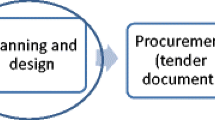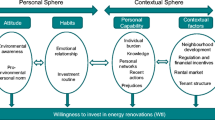Abstract
What factors increase the chance that residents/owners in housing cooperatives agree on sustainable energy efficient renovation? Based on 30 qualitative interviews with professional advisors in cooperative housing associations and chairman/board and residents in three chosen case studies, an analysis of opportunities and barriers for making a common decision on renovation is performed. Success criteria and barriers are found on the societal level as well as on the organizational/individual level. The barriers and success criteria identified on the societal level are: knowledge level on energy-efficient renovation among relevant actors, owner structure of the housing cooperative, and existing regulations and incentives. On the organizational and individual level, the following categories influencing renovation processes were identified: the time frame and organization of the process, understanding the residents` needs, economy, the information given, and the existence of available exemplary projects and role models. Based on the results of the study, ten guidelines that contribute to more successful decision making processes and increase the chances of sustainable energy efficient renovation in housing cooperatives are presented.
Similar content being viewed by others
Notes
The results are from the research project BESLUTT—Beslutningsprosesser I borettslag og sameier: Hva fører til bærekraftige oppgraderingsprosjekter financed by the Norwegian research council 2010–2012.
References
Abrahamse, W. & Steg, L. (2009). How do socio-demographic and psychological factors relate to households’ direct and indirect energy use and savings? Journal of economic psychology 30: 711–720. doi: 10.1016/j.joep.2009.05.006
Abrahamse, W., Steg, L., Vlek, C., & Rothengatter, T. (2007). The effect of tailored information, goalsetting, and tailored feedback on household energy use, energy-related behaviors, and behavioral antecedents. Journal of Environmental Psychology, 27, 265–276.
Ajzen, I. (1991). The theory of planned behavior. Organizational Behavior and Human Decision Processes, 50, 179–211.
Arnstad, E. (2010). Energi effektivisering av bygg, en realistisk og ambisiøs plan fram mot 2040. KRDs arbeidsgruppe for energieffektivisering av bygg. http://www.regjeringen.no/nb/dep/krd/aktuelt/nyheter/2010/Rapport-fra-arbeidsgruppa-for-energieffektivisering-av-bygg.html?id=612776
Boasson, E. L. (2009). Norsk byggenergipolitikk—mangfolding og inkonsistent. (Norwegian building energy policy—multiple and inconsistent.). Oslo: Fritjof Nansen Institute.
Brekke, K. A., Kipperberg, G. & Nyborg, K. (2007). Reluctant recyclers: social interaction in responsibility ascription, Memorandum 16/2007, Department of Economics, University of Oslo.
Corraliza, J. A., & Bergenguer, J. (2000). Environmental values, beliefs, and actions. A situational approach. Environment & Behavior, 32(6), 823–848.
Denscombe, M. (2003). The good research guide for small-scale social research projects (2nd ed.). Philadelphia: Open University Press.
Dokka, T. H., Hauge, G., Thyholt, M., Klinski, M., & Kirkhus, A. (2009). Energieffektivisering i bygninger—mye miljø for pengene! Prosjektrapport 40. Oslo: SINTEF Byggforsk.
Enkvist, P-A. et. al. (2007). A cost curve for greenhouse gas reduction. A global study of the size and cost of measures to reduce greenhouse gas emissions yields important insights for businesses and policy markers. The McKinsey Quaterly 2007, Number 1, Stockholm.
EU. (2010). 5386/3/10. Legislative acts and other instruments. Position of the council at first reading with a view to the adaption of a directive of the European parliament and the council on the energy performance of buildings. Brussels.
Flyvbjerg, B. (2004). Five misunderstandings about case-study research. In C. Seal, G. Gobo, J. F. Gubrium, & D. Silverman (Eds.), Qualitative research practice (pp. 420–434). London: Sage Publications.
Gram-Hanssen, K. (2010). Residential heat comfort practices: understanding users. Building Research and Information, 28(2), 175–186.
Grønmo, S. (2004). Samfunnsvitenskapelige metoder. Bergen: Fagboksførlaget.
Haavik, T, Aabrekk, S.E. (2007) ‘Business opportunities in sustainable housing. A Marketing guide based on experiences from 10 countries’, SHC task 28/ ECBCS Annex 38, Oslo, Husbanken.
Häkkinen, T., & Belloni, K. (2011). Barriers and drivers for sustainable building. Building Research and Information, 39(3), 239–255.
Hauge, Å. L. (2009). Housing and identity. The meaning of housing in communicating identity, and its influence on self-perception. PhD-thesis. NTNU: Trondheim.
Hauge, Å. L., Thomsen, J., & Berker, T. (2011). User evaluations of energy efficient buildings—literature review and further research. Advanced Energy Research, 5, 109–127.
IEA. (2009). World Energy Outlook. Paris: International Energy Agency. http://www.worldenergyoutlook.org/docs/weo2009/WEO2009_es_english.pdf
IPCC. (2007). Climate report.
Kvale, S. (1996). Interviews, an introduction to qualitative research interviewing. London: Sage Publications.
Löfström, E. (2008) Visualizing energy in households: the de-domestication of socio technical systems and individual as well as artecaft-bound energy use. Academic dissertation. Linköping university, Department of technology and social change: Linköping.
NBBL/ SINTEF Byggforsk. (2011). Få oppslutning om oppgradering! Veileder for styrer i boligselskaper. (Get support for renovation! Guidelines for boards in housing cooperatives!). Oslo: NBBL. http://www.nbbl.no/Aktuelt-fra-NBBL/Nyhetstema/Boligl%C3%B8ftet/BESLUTT
Prendergast, E., Mlecnik, E., Haavik, T., Rødsjø, A. & Parker, P. (2010). From demonstration projects to volume market. Market development for advanced housing renovation. Rapport for IEA SHC, task 37: Advanced housing renovation with solar & conservation. http://www.lavenergiboliger.no/hb/lavenergi.nsf/viewForside/C72E7C038835709BC12577B600295452!OpenDocument
Shove, E. (2010). Beyond the ABC: climate change policy and theories of social change. Environment and Planning A, 42, 1273–1285.
Steg, L. (2005). Car use: lust and must. Instrumental, symbolic and affective motives for car use. Transportation Research A, 39, 147–162.
Steg, L., & Vlek, C. (2009). Encouraging pro-environmental behavior: an integrative review and research agenda. Journal of Environmental Psychology, 29, 309–317.
Strumse, E. (2007). Psykologiske perspektiver på forholdet mellom mennesket og natur. Tidsskrift for norsk psykologforening, 44(nr 8), s 988–s 990.
Strumse, E. (2009). Miljøpsykologi og jakten på det gode liv. Tidsskrift for norsk psykologforening, 46(nr 8), s 730.
Uzzel, D. (2008). The challenge of climate change: the challenge for psychology. 43rd Australian Psychological Society Annual Conference, Hobart, Tasmania.
Yin, R. K. (2003). Case Study Research, design and methods (3rd ed.). California: Sage Publications.
Author information
Authors and Affiliations
Corresponding author
Rights and permissions
About this article
Cite this article
Hauge, Å.L., Thomsen, J. & Löfström, E. How to get residents/owners in housing cooperatives to agree on sustainable renovation. Energy Efficiency 6, 315–328 (2013). https://doi.org/10.1007/s12053-012-9175-5
Received:
Accepted:
Published:
Issue Date:
DOI: https://doi.org/10.1007/s12053-012-9175-5




